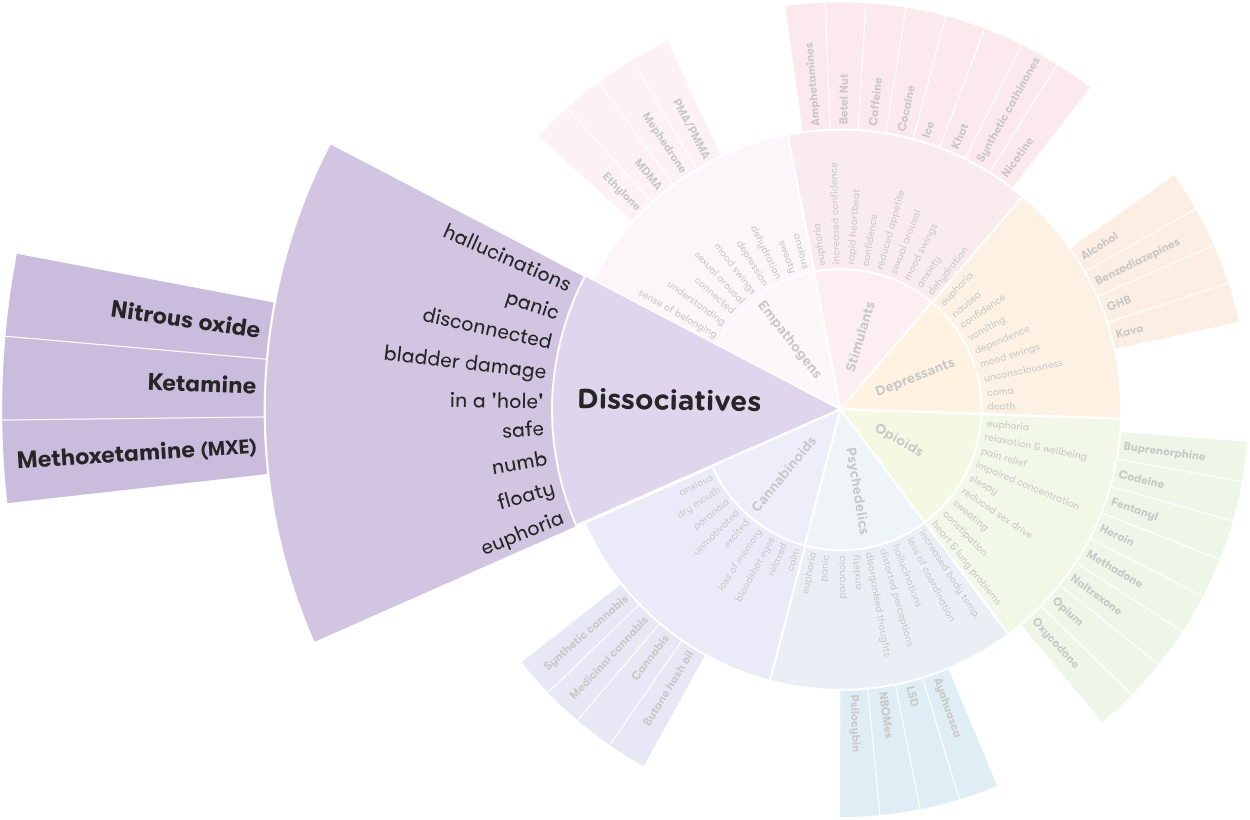what does laughing gas do to your brain
What is nitrous oxide?
Nitrous oxide is a colourless gas that is commonly used for sedation and pain relief, but is also used by people to experience intoxicated or high.1
It is ordinarily used by dentists and medical professionals to sedate patients undergoing minor medical procedures.1 It is also a food additive when used as a propellant for whipped cream, and is used in the automotive manufacture to raise engine performance. It is also increasingly being used to treat people withdrawing from booze dependence. Nitrous oxide is classified as a dissociative anaesthetic and has been establish to produce dissociation of the mind from the body (a sense of floating), distorted perceptions and in rare cases, visual hallucinations.2
How is it used?
The gas is inhaled, typically by discharging nitrous gas cartridges (bulbs or whippets) into another object, such every bit a balloon, or directly into the mouth.three Inhaling nitrous oxide produces a rapid rush of euphoria and feeling of floating or excitement for a brusque period of time.3
Other names
Laughing gas, nitro, N2O, NOS, nangs, whippet, hippy crack, buzz flop, balloons.
Furnishings of nitrous oxide
There is no prophylactic level of drug utilise. Use of whatsoever drug always carries chance. It'south important to be careful when taking any blazon of drug.
Nitrous oxide affects everyone differently, based on:
- the amount taken
- the user's size, weight and health
- whether the person is used to taking it
- whether other drugs are taken around the same time
The following effects may be felt nearly immediately and can last for a few minutes:2,four,5
- euphoria
- numbness of the body
- sedation
- giddiness
- uncontrolled laughter
- uncoordinated movements
- blurred vision
- confusion
- dizziness and/or light-headedness
- sweating
- feeling unusually tired or weak
- sudden death.
If a large amount of nitrous oxide is inhaled it can produce:2,iv,7
- loss of claret pressure level
- fainting
- middle set on.
Inhaling nitrous oxide tin be fatal if you don't become enough oxygen, which is known every bit hypoxia.two,3,v
Long-term effects
Prolonged exposure to nitrous oxide may consequence in:2,four,v,half dozen
- memory loss
- vitamin B12 depletion (long-term depletion causes brain and nervus damage)
- ringing or buzzing in the ears
- incontinence
- numbness in the easily or feet
- limb spasms
- potential birth defects (if consumed during pregnancy)
- weakened immune arrangement
- disruption to reproductive systems
- depression
- psychological dependence
- psychosis.
Mixing with other drugs
There is no current evidence demonstrating that mixing nitrous oxide with other substances increases health risks. However, information technology is possible that combining the gas with stimulants and other drugs places additional pressure on the eye, increases blood pressure and may disrupt heart rate.5
Anecdotal evidence suggests that combining nitrous oxide with other drugs such every bit cannabis, ketamine, LSD, magic mushroom and salvia tin cause intense dissociation.5,8
Mixing nitrous oxide and booze can cause:
- confusion
- feeling heavy or sluggish
- reduced concentration
- loss of body control.ix
More on Polydrug utilize
'Polydrug utilize' is a term for the utilize of more than one drug or type of drug at the same time or ane after another.1 Polydrug use tin can involve both illicit drugs and legal substances, such equally alcohol and medications.
Health and safety
When inhaling directly from tanks or whippets (bulbs), the gas is intensely cold (-40C degrees) and tin crusade frostbite to the nose, lips and pharynx (including vocal cords).five,ten As the gas is besides under constant force per unit area, information technology can cause ruptures in lung tissue when inhaled directly from these containers. Releasing the nitrous oxide into a balloon helps to warm the gas and normalise the pressure earlier inhaling.5,8
People can also harm themselves if they utilize faulty gas dispensers, which may explode. Dispensing several gas canisters consecutively with one cracker (a handheld device used to 'crevice' a nitrous oxide seedling/whippet) can also cause cold burns to the hands.five
Information technology is possible to reduce the risks associated with using nitrous oxide by not:
- using it alone or in dangerous or isolated places
- putting plastic numberless over the head or impeding breathing in any fashion
- spraying nearly flammable substances, such as naked flames or cigarettes
- drinking alcohol or taking other drugs
- standing or dancing while inhaling, as the user may pass out.iii,5
Withdrawal
At that place are no pregnant withdrawal symptoms autonomously from cravings to employ more than nitrous.1
Getting help
If your use of nitrous oxide is affecting your health, family, relationships, work, school, fiscal or other life situations, you lot tin can find help and support.
Call 1300 85 85 84 to speak to a real person and get answers to your questions as well as advice on practical 'next steps'.
Path2Help
Not certain what y'all are looking for?
Try our intuitive Path2Help tool and be matched with support data and services tailored to you.
Find out more

According to the Australian Trends in Ecstasy and Related Drug Markets 2016 Survey, around ane third (36%) of a sample of people who regularly use ecstasy and related drugs reported recent nitrous oxide use in the half dozen months preceding the survey. This is considerably higher than 2015 results (26%). Use was highest in Victoria (62%).10
- Malamed, SF & Clark, MS. (2003). Nitrous oxide-oxygen: a new expect at a very sometime technique. Journal of the California Dental Association, 31(5), 397-404.
- Brands, B, Sproule, E & Marshman, J. (1998). Drugs and Drug Corruption.Toronto: Addiction Research Foundation.
- Papanastasiou, C & Dietze, P. (2015). Just a laughing affair? Nitrous oxide use among a group of regular psychostimulant users in Melbourne, Victoria. Poster. Melbourne: Centre for Population Health, Burnet Found.
- Re-Solv. (n.d.). Nitrous Oxide.
- Drug Scientific discipline. (2012). Nitrous Oxide.
- Garland, EL, Howard, MO, & Perron, Be. (2009). Nitrous oxide inhalation among adolescents: Prevalence, correlates, and co-occurrence with volatile solvent inhalation. Journal of Psychoactive Drugs, 41(4), 337-347.
- UK Dwelling house Office. (2014). Guidance on restricting the supply of nitrous oxide for recreational apply.
- Zacny, JP, Camarillo, VM, Sadeghi, P, & Black, M. (1998). Effects of ethanol and nitrous oxide, solitary and in combination, on mood, psychomotor performance and hurting reports in healthy volunteers. Drug and Alcohol Dependence, 52(two), 115-123.
- Sindicich, Northward. & Burns, Fifty. (2016). Finding from the Ecstasy and Related Drugs Reporting System (EDRS).

Source: https://adf.org.au/drug-facts/nitrous-oxide/
0 Response to "what does laughing gas do to your brain"
Post a Comment